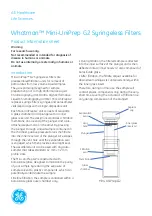
Care &
Maintenance
Sprinklers must be handled care-
fully. They must not be transported
or stored where ambient temperature
may exceed 100
°
F/38
°
C. For best
results, store them in a dry, cool
location in the original shipping
package.
Do not install sprinklers that have
been dropped or visibly damaged.
Sprinklers must never be painted,
coated, plated, or altered in any other
way from manufactured condition or
they may not function properly. Any
sprinklers altered in such manner
must be replaced.
The owner is responsible for the
proper operating condition of all fire
protection devices and accessories.
The NFPA standard 25 entitled,
“Inspection, Testing and Maintenance
of Water-Based Fire Protection
Systems”, contains guidelines and
minimum maintenance requirements.
Furthermore, the local
Authority
Having Jurisdiction may have addi-
tional regulations and requirements
for maintenance, testing, and inspec-
tion that must be obeyed.
It is advisable to have sprinkler
systems inspected regularly by a
qualified inspection service. Length of
time between such inspections can
vary due to accessibility, ambient
atmosphere, water supply, and site
activity.
Do not attempt to reassemble or
otherwise reuse a sprinkler that has
operated. Replace any sprinkler
exhibiting corrosion or damage;
always use new sprinklers of the
same type and temperature rating as
replacements.
Because the discharge pattern is
critical to protection of life and
property, nothing should be hung or
attached to the sprinkler unit that
would disrupt the pattern. Such
obstructions must be removed. In the
event that construction has altered
the original configuration, the system
must be investigated and the protec-
tion level maintained.
Installation
The Model ELO LH incorporates
the latest in heat-responsive glass
bulb technology. The operating
mechanism consists of a 3 mm liquid-
filled frangible capsule that is only 2.0
cm in length.
Operation: The glass bulb capsule
operating mechanism contains a
heat-sensitive liquid that expands
upon application of heat. At the rated
temperature, the frangible capsule
ruptures, thereby releasing the orifice
seal. The sprinkler then discharges
water in a pre-designed spray pattern
to control the fire.
All Central Model ELO LH Re-
cessed Pendent and Pendent Auto-
matic Sprinklers must be installed
according to the current NFPA 13
Standard and these installation
instructions. Deviations from these
requirements and standards or any
alteration to the sprinkler itself will
void any warranty made by Central
Sprinkler Company. In addition,
installation must also meet local
government provisions, codes, and
standards as applicable.
The system piping must be properly
Caution: Minimum spacing between pendent and recessed
pendent sprinklers is 11'-0".
Maximum
Minimum Design
Minimum Design
Spacing Between
Location From
Flow per Sprinkler
Pressure per Sprinkler
Sprinklers
Any Wall
(gpm)
(psi)
*16 x 16 feet (256 sq. ft.)
8 feet
30.2 gpm
7 psi
*18 x 18 feet (324 sq. ft.)
9 feet
33.0 gpm
8.4 psi
**20 x 20 feet (400 sq. ft.)
10 feet
40.0 gpm
12.3 psi
Design Requirements — Light Hazard Extended Coverage Applications
Density .1 GPM/ft
2
- NFPA 13 All Editions
Temperature Rating 155
°
F/68
°
C,200
°
F/93
°
C,250
°
F/121
°
C Temperatures
Design
Data
sized to ensure the minimum required
flow rate at the sprinkler. Check for
the proper model, style, orifice size,
and temperature rating prior to
installation. Install sprinklers after the
piping is in place to avoid mechanical
damage; replace any damaged units.
Wet pipe systems must be
protected from freezing.
Upon completion of the installation,
the system must be tested per
recognized standards.
In the event of a thread leak,
remove the unit, apply new pipe joint
compound or tape, and reinstall.
Installation Sequence
Step 1. For Pendent and Recessed
Pendent sprinklers, the face of the
sprinkler fitting should be installed a
nominal
3
⁄
4
" (
±
3
⁄
8
") behind the ceiling
line. Adjustments are made via the
push-on escutcheon.
Step 2. Use only a non-hardening
pipe joint compound or Teflon* tape.
Apply only to the male threads.
Step 3. Hand tighten the sprinkler
into the fitting. Use a Central
Sprinkler Wrench, to tighten the unit
into the fitting. A leak-tight joint
requires only 7 to 14 ft.-lbs. of torque;
a tangential force of 14 to 28 lbs.
delivered through a 6" handle will
deliver adequate torque. Torque
levels over 21 ft.-lbs. may distort the
orifice seal, resulting in leakage.
*Teflon is a trademark of the DuPont Corp.
* Listed as Quick Response.
** Listed as Standard Response Only.
≠
Recessed Pendent Sprinkler is Listed as Standard Response Only.
OBSOLETE






















